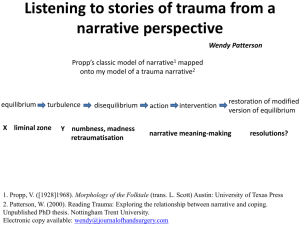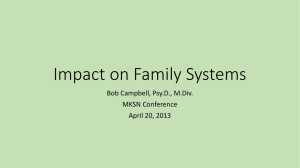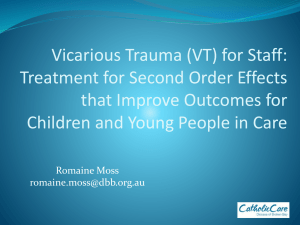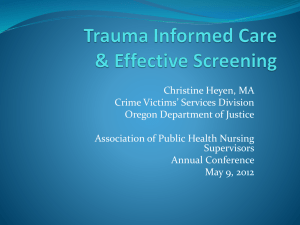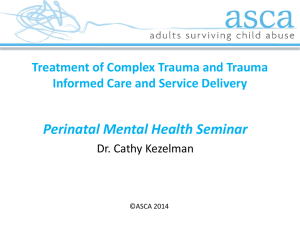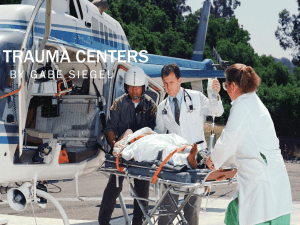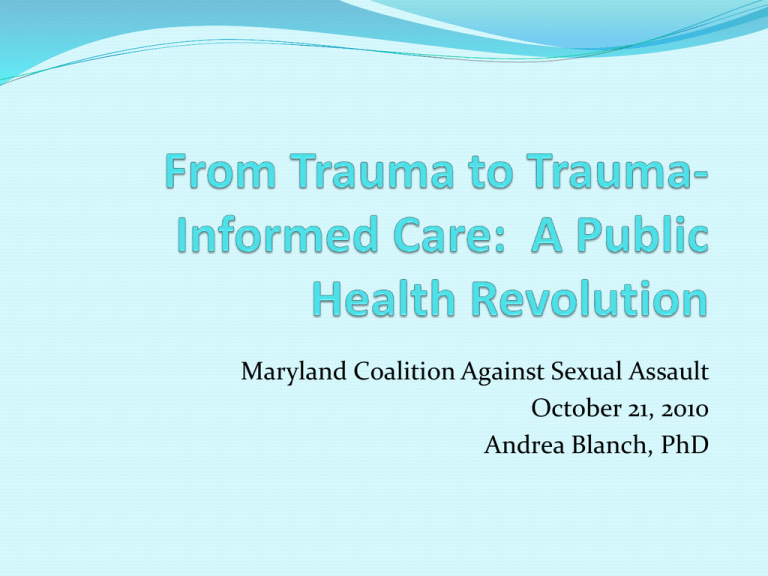
Maryland Coalition Against Sexual Assault
October 21, 2010
Andrea Blanch, PhD
Bringing it Home
Almost everyone you serve has a trauma
history. So do many staff & volunteers
Some of the thorniest problems in human
services result from undiagnosed trauma
When we name the problem correctly,
solutions emerge
Vulnerable Populations
Women & children
AI/AN
People with disabilities
Veterans
Refugees & immigrants
People who are homeless
People in institutions
People experiencing
chronic poverty, racism
Types of Trauma
War
Oppression
Cultural change
Natural disaster
Interpersonal violence
Racism, poverty
Historical trauma
Institutional trauma
Social Consequences
1.
2.
3.
4.
5.
6.
7.
Rank of 47th in longevity and 29th in infant mortality
Highest prevalence rates in the world of behavioral
health disorders
Homicide rate higher than 18 other countries, 6x rate
of lowest countries and 2x next highest (Israel)
Incarceration rate highest in the world
Compared to 20 “wealthy” countries, 2nd highest
poverty rates overall & children (next to Mexico)
21st in science, 25th in math literacy
Work 200 hrs/longer than other countries,
Call to Action
Focus on Gender
1800 BC First written legal code establishes
women as property of men
1769 - 1776 Women as property enshrined in
English and US legal codes
1962 US court rules that men don’t have the
right to beat their wives
1980’s US courts begin ruling that men do not
have the right to rape their wives
1994 Violence Against Women Act passed by
US Congress
Changing Perspective on Trauma
1970’s “Shell shock” reformulated as PTSD in
Vietnam Vets
1980’s Domestic violence field brings attention to
violence against women
1998 – 2003 SAMHSA study shows that people
seen as mentally ill, substance abusers or criminal
are trauma survivors, highlights resilience
2000’s ACE study reveals implications for health
care, social services, communities
2010’s Public health model
Changes in Understanding: The
Centrality of Trauma
Incarceration
Homelessness
Violence and
Trauma
Substance
Abuse
Mental Health
Problems
Suicide
PTSD
SMI
Context is Critical
Trauma survivors
are normal people
who have been
exposed to
extreme events
Public Health Revolution
Mid-1800’s:
Industrialization
Epidemic killed millions
Average lifespan of industrial worker = 15 years
Mid-1900’s:
Contagious diseases under control
Greatest reduction of mortality in history
Public health infrastructure taken for granted
What Changed?
New Science: The Germ Theory
John Snow – removed pump handle, ended epidemic
Louis Pasteur - germs cause disease
Robert Koch - identified cholera bacillus
New Techniques
Public hygeine measures to prevent exposure
Vaccinations to prevent contagion
Antibiotics to cure infection
Political Action
Legislation
Public health infrastructure
“Germ Theory” of Trauma
Epidemiology
ACE study
Statistics re incidence and prevalence
Model of Contagion
Trauma-violence cycle
Intergenerational and historical transmission
Causal Mechanism – neurobiological research
Stuck on “High”
Hyper-arousal
Depression
Disconnection
Exhaustion/Fatigue
Numbness
Slide by Elaine Miller-Karas &
L. Leitch(c)2007
Key Concepts of TRM
Hyperactivity
Hypervigilance
Mania
Anxiety & Panic
Rage
Normal Range
Window of Tolerance
Traumatic
Event!
Stuck on “Low”
Hypo-arousal
Trauma as a Public Health Issue
New Techniques for Intervention
Violence prevention to reduce exposure
Secondary prevention to reduce contagion
Trauma treatment & trauma-informed care
Political Action
Legislation to reduce violence
Infrastructure to support trauma informed
care
Cycle of Intervention
Public
Awareness
Prevention &
Resilience
Early
Identification
& Intervention
Social
Action
Healing
Effective
Prevention
Programs
Exist
Supporting
Resilience
Common – even
normative
Multidimensional
Post traumatic
growth is possible
Supporting Youth Resilience
Nurse-Family Partnership
Positive Parenting Programs
School-based Resilience
Programs
Therapeutic Foster Care
Trauma Treatment & Trauma
Informed Care
Trauma specific treatments are
designed to address symptoms of
trauma
Trauma-informed services incorporate
knowledge about trauma in all aspects
of service delivery
TIC as Unifying Principle
Every agency, office and department
has a role in preventing & healing
trauma
Brings together local leaders to reduce
violence & create “trauma informed
communities”
Provides a way for every person to get
involved
Trauma Informed Practice
Religious settings
Art classes
Job programs
Advocacy
Housing
ESL classes
Schoolrooms
Law enforcement
Healthcare
Characteristics of TIC
1.
2.
3.
4.
5.
6.
Knowledgeable re trauma
Uses universal precautions
Supports self healing
Basic needs come first
Respects cultural & gender
differences
Focuses on both clients & staff
1. Knowledge about Trauma
Recognize symptoms & behavioral
manifestations
Ask: “What happened to you?” rather
than “What’s wrong with you?”
Understands power and privilege
Ex: Self Inflicted Violence
What is it?
Why do people do it?
Does it have a relationship to
childhood trauma?
“The earlier the abuse, the more selfdirected the aggression” Bessel van de Kolk, MD
From Ruta Mazelis
2. Universal Precautions
Fair assumption?
Redesigned environment benefits
everyone and avoids retraumatization
Asking IS important – especially in the
beginning
Trauma informed assessment process
3. Self Healing & Self Care
Voice
Deep listening
Inventory self-
healing
Internal &
external resources
Peer involvement
Healing Narratives
Factual accounting
Helper as learner
Construction of
meaning
Storytelling
coaches
Combine with
political action
4. Basic Needs
1) Somatic health
complaints
2) Economic
marginalization
3) Non-clinical emotional
distress
4) Dissatisfaction w.
political situation
5) Psychological impact
5. Cultural & Gender Differences
Common Cultural Mistakes
Focus on extreme
forms of violence
Failure to consider
social and political
context
Fail to recognize
culturally-specific
behaviors & symptoms
Using Cultural Resources
Religion and Spirituality
6. Focuses on Staff & Clients
Many clients & staff have
trauma in background
Organization may hold
traumatic memories
Workplace may involve
toxic stress
External environment
imposes stressors
Sources of Organizational Trauma
Patient death or injury
Staff injury
Lawsuit
Adverse media
Financial crisis
Layoffs
Reorganization
Chronic understaffing
TIC for Staff & Clients
Safety
Trustworthiness
Choice
Collaboration
Empowerment
Trauma-Informed Partnerships
War as a Psychosocial Trauma
War affects a
whole population
not as individuals
but as a totality,
as a system
What does a traumatized society
look like?
Fear-driven social policies
Obsessive focus on security
Extreme, rigid conservatism
Chronic state of low grade paranoia
Exaggerated nationalism
Projection of anger and fear onto the “other”
Scapegoating of target groups
Where Are We?
Established theory
Effective Techniques
Political Action
Women, if the soul of the nation is to
be saved, I believe that you must
become its soul.
Coretta Scott King




